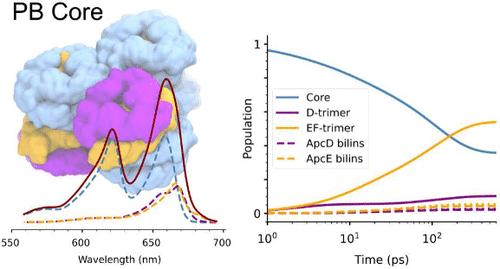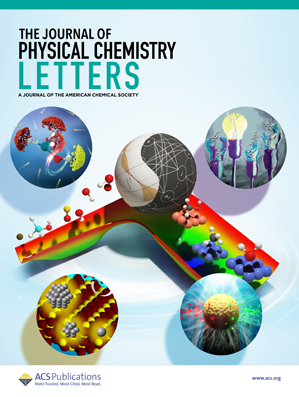从量子化学建模看藻核的能量分布和末端发射体
IF 4.8
2区 化学
Q2 CHEMISTRY, PHYSICAL
引用次数: 0
摘要
藻青素体(PB)是蓝藻的巨型超级天线复合体,利用藻青素色素捕捉阳光,并将收集到的能量转移到膜上的光合系统。在 PB 核心中,藻胆素与特定的异藻蓝蛋白(APC)结合。一些藻青素被认为是具有红移荧光的末端发射体(TE)。然而,如何准确识别藻青素仍存在争议。在这项工作中,我们采用多尺度量子力学计算方法来揭示 PB 核心的激发能谱。利用来自 Synechoccoccus PCC 7002 和 Synechocystis PCC 6803 的最新原子论 PB 结构,我们计算了不同 APC 三聚体的光谱特性,并分配了低能色素。我们发现,APC 植物色素的激发能量由几何和静电因素决定,并通过核心内特定的蛋白质-蛋白质相互作用进行调整。我们的研究结果对 PB 核心中少数红移双链蛋白的简单描述提出了质疑,而表明红移是由整个含有 TE 的 APC 三聚体确定的。我们的工作为解释藻体中的能量迁移和时间分辨光谱提供了微观理论基础。本文章由计算机程序翻译,如有差异,请以英文原文为准。

Energetic Landscape and Terminal Emitters of Phycobilisome Cores from Quantum Chemical Modeling
Phycobilisomes (PBs) are giant antenna supercomplexes of cyanobacteria that use phycobilin pigments to capture sunlight and transfer the collected energy to membrane-bound photosystems. In the PB core, phycobilins are bound to particular allophycocyanin (APC) proteins. Some phycobilins are thought to be terminal emitters (TEs) with red-shifted fluorescence. However, the precise identification of TEs is still under debate. In this work, we employ multiscale quantum-mechanical calculations to disentangle the excitation energy landscape of PB cores. Using the recent atomistic PB structures from Synechoccoccus PCC 7002 and Synechocystis PCC 6803, we compute the spectral properties of different APC trimers and assign the low-energy pigments. We show that the excitation energy of APC phycobilins is determined by geometric and electrostatic factors and is tuned by the specific protein–protein interactions within the core. Our findings challenge the simple picture of a few red-shifted bilins in the PB core and instead suggest that the red-shifts are established by the entire TE-containing APC trimers. Our work provides a theoretical microscopic basis for the interpretation of energy migration and time-resolved spectroscopy in phycobilisomes.
求助全文
通过发布文献求助,成功后即可免费获取论文全文。
去求助
来源期刊

The Journal of Physical Chemistry Letters
CHEMISTRY, PHYSICAL-NANOSCIENCE & NANOTECHNOLOGY
CiteScore
9.60
自引率
7.00%
发文量
1519
审稿时长
1.6 months
期刊介绍:
The Journal of Physical Chemistry (JPC) Letters is devoted to reporting new and original experimental and theoretical basic research of interest to physical chemists, biophysical chemists, chemical physicists, physicists, material scientists, and engineers. An important criterion for acceptance is that the paper reports a significant scientific advance and/or physical insight such that rapid publication is essential. Two issues of JPC Letters are published each month.
 求助内容:
求助内容: 应助结果提醒方式:
应助结果提醒方式:


